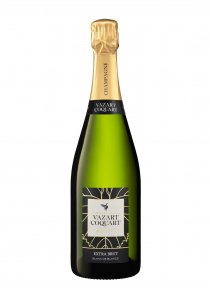
All about the dosage of champagne
The dosage is an essential step in the development of champagne, yet it remains one of the most unknown. It is the last operation carried out by the winemaker or the cellar master. After spending a minimum of 18 months in the cellars, the champagne bottles are disgorged. This operation consists in expelling the deposit accumulated in the neck of the bottle. During the operation a small part of the wine is lost, it must then be replaced by an equivalent volume of what is then called an expedition liqueur. This liqueur is a marriage of reserve wine (wines from previous harvests) and sugar. Adding this liqueur to freshly disgorged champagne is called the dosage. The amount of sugar in this mixture will thus determine the type of dosage and therefore the type of champagne. Knowing the meaning of the dosage allows you to buy champagne with all the information in hand.
Champagne Brut soon out of date ?
The usual dosage of champagne is between 8 and 12g of sugar per liter, it is the one found in Brut champagnes. But the legislation has defined a precise scale allowing to qualify a champagne cuvée:
Champagne Brut Nature : refers to a champagne for which no dosage has been added.
Champagne Extra Brut : between 0 and 6g of sugar per liter.
Champagne Brut : less than 12g of sugar per liter.
Champagne Extra Sec : between 12 and 17g of sugar per liter.
Champagne Sec : between 17 and 32g of sugar per liter.
Champagne Demi-Sec : 32 to 50g of sugar per liter.
Champagne Doux : more than 50g of sugar per liter.
Sparkling wine Less and less dosed
Beyond the simple function of replacing the wine lost during disgorging, the dosage therefore makes it possible to bring a sweet touch to the champagne, and a unique style. The champagne houses jealously keep the recipe for their dosage secret. It is rumored that such and such a house will add a touch of armagnac, while another will add a touch of old wine aged in small oak barrels. But dosage has another less well-known and less glorious virtue. For some winegrowers, a large dosage makes it possible to round off and make acceptable a champagne that is too acidic or poorly prepared. For years the dosage has tended to be less and less important in Champagne. Very sweet champagne (dry champagne) that was served in the 19th century at tea time, and in which some even added a piece of sugar to give even more taste, but also to give birth to new bubbles, we switched to brut champagne often dosed at less than 8g per liter and at the birth of many natural cuvées. An evolution of the dosage which reflects the evolution of consumer tastes, but which also symbolizes the great progress made in champagne vinification. Some winegrowers like Francis Boulard only offer their champagnes in Extra brut and in Nature.
How to pair Champagne ?
While the fashion is clearly for plain champagnes, it is nevertheless advisable to approach the tasting of these cuvées with caution, as they can initially throw off the uninitiated palate. But quickly, we will be able to appreciate a non-dosed champagne for the finesse and purity of its aromas. If it is impossible to give absolute rules for food-champagne pairings, the dosage remains an interesting clue. So we can try the following :
- Champagne demi-sec : on a creamy or chocolate dessert or on a foie gras
- Champagne brut : on a Parmesan or a Gruyére, on a cold vegetable-based starter or on a fish in sauce.
- Champagne extra-brut ou nature : on shellfish, seafood or grilled fish.






